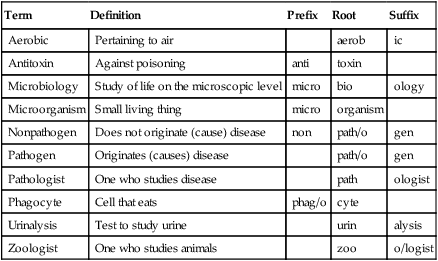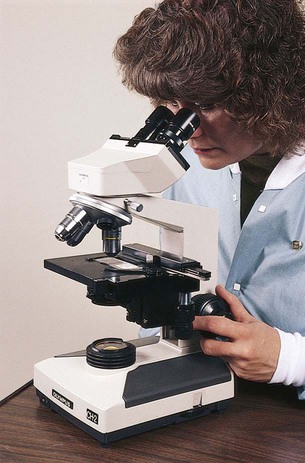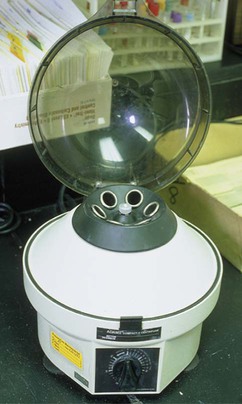Chapter22 Laboratory Careers Terminology* *A transition syllable or vowel may be added to or deleted from the word parts to make the combining form. Laboratory careers include workers with a broad range of interests and abilities (Box 22-1). Life scientists use advanced biomedical technology to assist with diagnosis and treatment of patients, as well as monitoring public health. Opportunities in this area include clinical laboratory, blood banking, research, and related fields in life science (Table 22-1). TABLE 22-1 Laboratory Career Opportunities The pathologist is a medical doctor who examines specimens of body tissue, fluids, and secretions to diagnose disease (Fig. 22-1). Other medical practitioners rely on the pathologist as a consultant who determines the effectiveness of treatments and the cause of death. The pathologist must first complete medical school and then obtain specialized education and training in this area. Hospitals, medical schools, all levels of government, and private industry employ pathologists. In many hospitals the pathologist supervises the laboratory. The laboratory technologist, also called the clinical laboratory scientist, performs clinical laboratory testing and analyzes the results, using independent judgment. For example, the technologist cross-matches blood to be used for transfusion. The technologist calibrates the equipment and assists in determining the accuracy and utility of new tests and procedures under the supervision of the pathologist or laboratory supervisor. Technologists usually complete a bachelor’s degree followed by a training program of up to 1 year long (Table 22-2). The Board of Registry for Laboratory Technologists requires a baccalaureate degree and an examination to become a certified technologist. Licensure of technologists is required in some states. TABLE 22-2 Laboratory Career Educational Cost and Earnings *(2010-2011) https://financialaid.arizona.edu/money/estimated-cost.aspx. Several areas of specialization are possible for the laboratory technologist. The microbiology technologist may collect the specimen directly from the patient or receive materials from an autopsy. The technologist then grows and isolates the microorganisms to assist with their identification (Fig. 22-2). Cytotechnologists specialize in the preparation and screening of cells for diagnosis after collection by scraping, brushing, or aspirating body cells from an organ or site (Fig. 22-3). These microscopic cells may be used to diagnose cancer, infectious agents, or inflammation. Chemistry technologists analyze body fluids and wastes. Other areas of specialization are the study of blood (hematology) and the study of resistance to pathogens (immunology). Medical laboratory assistants (MLAs) perform routine tests under the supervision of the technologist or other qualified personnel. Areas of testing that are performed by the assistant may include urinalysis, hematology, serology, and bacteriology. MLAs complete 1 year of training in a hospital or 2 years in college or vocational programs. Certification is possible after successful completion of an accredited program and a registry examination. Phlebotomists obtain and process blood specimens to aid in the diagnosis and treatment of disease (Fig. 22-4). Phlebotomists may be trained on the job or in community college or vocational programs. Life scientists are researchers who study living organisms and life processes including growth and reproduction. Many areas of specialization are possible in research and development in the health care industry. The educational requirements for research are a master’s degree or doctoral-level preparation. Medical research is conducted in the areas of biology, anatomy, biochemistry, genetics, physics, physiology, and microbiology. Life scientists are responsible for the development of new drugs, plant varieties, methods of treatment, and methods of environmental protection. Biotechnologists or genetic engineers explore the genetic design of plants and animals. Chapter 35 provides more information regarding career opportunities in biotechnology. About one fourth of life scientists work for the federal government, and one third work in private industry. Universities and similar agencies employ others.
Laboratory Careers
 Define at least 10 terms relating to laboratory careers.
Define at least 10 terms relating to laboratory careers.
 Specify the role of selected laboratory health care workers including personal characteristics, levels of education, and credentialing requirements.
Specify the role of selected laboratory health care workers including personal characteristics, levels of education, and credentialing requirements.
 Differentiate between pathogenic and nonpathogenic microorganisms.
Differentiate between pathogenic and nonpathogenic microorganisms.
 Identify six groups of organisms that may be pathogenic in humans.
Identify six groups of organisms that may be pathogenic in humans.
 Describe the conditions that are favorable for growth of microorganisms.
Describe the conditions that are favorable for growth of microorganisms.
 Identify three ways in which the skin serves as a defense against infection.
Identify three ways in which the skin serves as a defense against infection.
Term
Definition
Prefix
Root
Suffix
Aerobic
Pertaining to air
aerob
ic
Antitoxin
Against poisoning
anti
toxin
Microbiology
Study of life on the microscopic level
micro
bio
ology
Microorganism
Small living thing
micro
organism
Nonpathogen
Does not originate (cause) disease
non
path/o
gen
Pathogen
Originates (causes) disease
path/o
gen
Pathologist
One who studies disease
path
ologist
Phagocyte
Cell that eats
phag/o
cyte
Urinalysis
Test to study urine
urin
alysis
Zoologist
One who studies animals
zoo
o/logist

Careers
Career
Education Required
Laboratory assistant
1-2 yr hospital training, college, or vocational school
Laboratory technician
Associate degree or specialized training
Clinical laboratory scientist or medical technologist
Bachelor’s degree and specialized training
Pathologist
Medical doctor degree and specialized training
Clinical Laboratory Science
Career
Educational Cost*
Earnings*
Medical laboratory technologist
Bachelor of science in clinical laboratory science, University of Arizona;
Tuition (in state) $8237
Room and board $9024
Books and supplies $1000
Travel $1682
Other $2438
Median annual salary: Tucson, Ariz.—$52,670

Life Science
![]()
Stay updated, free articles. Join our Telegram channel

Full access? Get Clinical Tree


Nurse Key
Fastest Nurse Insight Engine
Get Clinical Tree app for offline access




